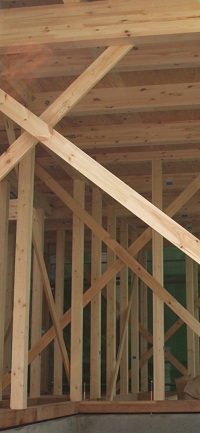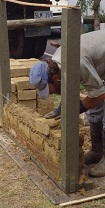Study alternative construction with this distance learning course and become an expert in healthy buildings and alternative construction methods
This course provides you with a solid foundation to develop your knowledge in alternative, ecologically friendly, sustainable and psychologically healthy buildings.
-
 Learn about the elements of building design and construction - the use of different and alternative materials, and considerations for healthy environments.
Learn about the elements of building design and construction - the use of different and alternative materials, and considerations for healthy environments.
- This course is suitable for anyone who is involved in building, from a large to a small scale.
- Offer unique, niche, individually designed buildings to meet your customers’ requirements or build for yourself.Learn more about healthy buildings and mud brick construction.
- Study three 100 hour modules - Healthy Buildings I and II, and Mud Brick Construction. Then complete a 200 hour workplace project.
- Flexible study - start at any time and study when and where you want to. We offer full tutoral support for the duration of your studies.
CORE MODULES
Healthy Buildings I (Healthy Buildings Construction) BSS200
This module looks at the impact of building construction on human physiological and physical health. Through 10 lessons, students will learn about building biology, building diseases, the impact of services, light, colour, ventilation and much more.
Healthy Buildings II (Building Environment & Health) BSS300
The Healthy Buildings II module builds on the knowledge gained in the previous module and also looks at additional areas such as the impact of the location upon health and surroundings to a building. As well as considering the materials used in buildings and, in particular, materials or finishes used, the module looks at additional elements such as the management of interior environments and consulting services that can be offered to clients.
 Mud Brick Construction ASS103
Mud Brick Construction ASS103
This 10 lesson module looks at the processes involved with constructing buildings with alternative materials such as mud bricks. Students will learn about the different materials that may be used and how they are made. The module considers all of the important elements of the building process, from planning and building regulations, through the selection of materials, to site management and the provision of services (water, electricity, etc.).
Workplace Project
To complete this qualification, you are also required to complete a workplace project lasting 200 hours.
There are 4 options available to you to satisfy this requirement. The options will be different dependent upon whether or not you currently work within the industry. The project can be work experience, voluntary experience, a project you carry out, other training you have already undertaken and there are other options. Don’t worry if you are not sure how to proceed at this stage, as your tutor will be there to discuss how to proceed and help you every step of the way.
WHERE IS IT APPROPRIATE TO BUILD WITH EARTH?
Earth building can be done anywhere' but if you want to minimize maintenance needed; you need a location with protection from excessive water.
Earth walls are susceptible to moisture. For this reason, flood prone sites are totally unsuitable for earth building. Sites in low rainfall areas are generally preferable, though extended roofing over the walls (e.g. large eves or verandas) can protect earth walls in even high rainfall areas. Less cost and effort is required to protect walls from weathering in drier climates though. If there is any chance whatsoever of walls being badly weathered by rain or flooding, cement stabilisation is recommended.
If a building is situated on top of a hill, there will be minimal problems with the drainage of water. Whereas, on the side of a hill, drainage can become a critical problem. Water coming down the hill must be caught and diverted away from the building, especially in the heaviest of rains. Two series of drains are recommended - one close to the building and the other further away. Both should be positioned up-hill of the building. Reshaping the earth can also be an advantage, creating contours which will divert water to the sides of the building.
If a building is on a flat site, foundations will generally be less involved and less costly. If building on a slope it is not advisable to build on a slab foundation laid on an area levelled using a cut and fill technique. The filled section of a cut and filled site is likely to subside causing structural problems to a building built over it.
When purchasing land you should consider the following if you have any intention of putting an earth building on the site:
- Check boundary pegs against measurements of the site.
- Be sure you are buying what you are looking at.
- Check any zoning regulations (i.e. town Planning) which apply to the site, and make sure you can use it in the way you want to use it. You might consider if it can be used for a business, whether trees can be removed, what types of buildings can be built etc.
- Consider the aspect. On a north slope (in the southern hemisphere) you will make better use of solar energy. A south slope could be cooler in summer.
- Consider the weather; wind patterns, rainfall, temperature patterns etc.
- Consider the amount of work and expense in preparing the site for building (e.g. cost of clearing, drainage, excavation, access roads, bringing in power and water etc).
- Access roads are important. A block which is accessible in summer might not be in winter.
- Consider what services (e.g. water, gas, phone, electricity, postal services, garbage collection etc) are available.
- Consider pest problems (e.g. termites, rabbits or other pests can affect both building construction or the garden you might be trying to establish)
- Rock below the surface or as outcrops on a site can affect the cost of building considerably. You may be required to blast rock for sewer pipes, a septic tank or even building foundations. Digging or blasting rock can be very expensive.
- Be aware of springs, boggy ground etc which can cause flooding.
Why Study with ACS?
Design your own learning pathway.
Study at your own pace, from anywhere, at any time.
Receive prompt, expert support from our team of committed and friendly tutors.
Your learning is our priority. We are flexible and adaptable to meet your educational needs!
Enrolling is easy - just go to the top of this page and select your study method and payment option.
If you have any questions about studying with ACS, or want to know more about any of our courses, get in touch with our specialist tutors today. They will be happy to answer your questions and look at different study options to fit in with your goals.